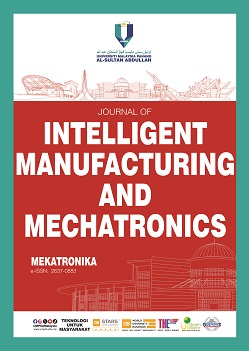A Study of Engineering Student IQ and EQ Based on Analyzing of Electroencephalogram (EEG) Signals
DOI:
https://doi.org/10.15282/mekatronika.v5i2.9853Keywords:
EEG, IQ, EQ, Power Spectrum Density, EEG Frequency Bands, k-NN, GUIAbstract
This paper elaborates about the analyzing of Intelligent Quotient (IQ) and Emotional Quotient (EQ) of an engineering student based on Electroencephalogram (EEG) or brain signals using a computing tool such as MATLAB. The influence of individual’s IQ and EQ on the development of innovative thinking is significant. An IQ alone is not adequate to measure the success of a person. An EQ somehow is found to have a substantial correlation with individual’s performance which shows that both IQ and EQ are important in determining the character and manner of individual’s thinking skills. The main objective of this project is to analyze the output of EEG signals produced by an engineering student based on their IQ and EQ level. A comparison of which quotient influences the student’s thinking skill is also observed in this study. In this project, a single channel EEG amplifier is used to record the EEG signals from 6 different subjects with three different conditions: while not doing anything, during an IQ test and during an EQ test. The data is recorded using the EEG sensors with Unicorn Recorder software that is connected to the amplifier while recording is run. The result of the experiment also explained in terms of the mean value and standard deviation of the EEG bands for each subject and condition. The results of the study conclude that the IQ level of an individual is affected by the Beta band of the EEG signals. Meanwhile, Alpha band of the EEG signals is more dominant in the determination of EQ level of an individual. When Alpha band is higher than Beta band, it shows that the subject is dominant to an EQ dominant person. If Beta band is higher than Alpha band, then IQ is the dominant quotient for the subject. The highest k-NN classification accuracy is obtained at 80:20 classification with 81.84% accuracy using Mean features and 79.53% accuracy using Standard Deviaton features. This study also included the development of Graphical User Interface (GUI) in MATLAB. The GUI is used for the classification of the chosen EEG features. Theta, Alpha, and Beta power band are observed from the EEG signals to identify brain activity. In addition, IQ and EQ analyzer is constructed using Arduino microcontroller once the analysis of the EEG signals are done through GUI.
Downloads
Published
Issue
Section
License
Copyright (c) 2023 Universiti Malaysia Pahang Publishing

This work is licensed under a Creative Commons Attribution-NonCommercial 4.0 International License.




